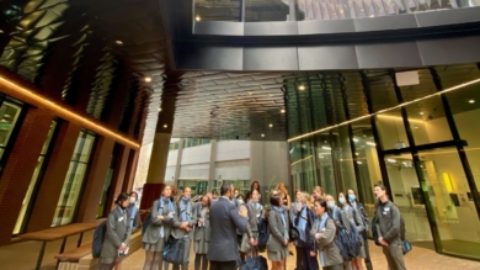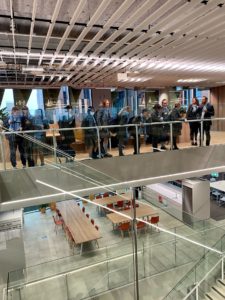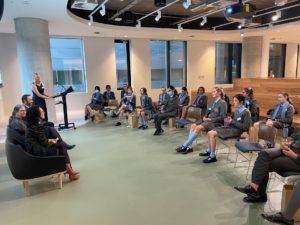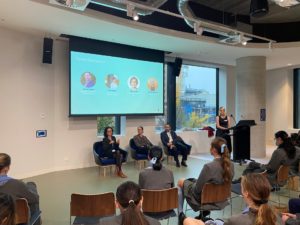Dexus Future Leaders in Property

A Focus on Sustainability
The Year 9 Finance, Business and Entrepreneurship Elective Class were fortunate to visit the newly completed Melbourne Connect building, in partnership with Dexus and Melbourne University. The Future Leaders in Property Program facilitated for St Catherine’s Year 9 students by Dexus, is focused on broadening the awareness of our students in career opportunities and is designed to inform their VCE subject selection in Year 10 and beyond.
The focus of our recent visit to Melbourne Connect was to develop an understanding of the context of ‘sustainability’ in building and accommodating the changing nature of work with a focus on Wellbeing. The Melbourne Connect Building was designed to cater for 850 staff and graduate researchers together with Industry, Government and Research Partners in accommodating the changing needs of a work place. Such examples include child care facilities, ergonomic work stations, provision of shower facilities and bike rakes and social hubs for staff.
The design focus in the development of Melbourne Connect was on sustainability and well-being. Consideration in designing Melbourne Connect included many factors including; Air, water, nourishment, light, movement, thermal comfort, sound, materials, mind and community. We were fortunate to learn from Warren Power, Dexus ‘6 Ideas’ team; Ellie Schwab from Dexus and Sarah Nickas from Melbourne University.
Our Year 9 students have reflected on each visit with Dexus, with three questions to facilitate their reflection:
What did you learn?
- I learned how they reinforced optimal working conditions (Temperature, lighting, etc) to make sure that workers can get the most out of the day. Seeing as there are no external factors to worry about, the environment that Melbourne Connect creates enhances performance among all faculties.
- I learnt that the Melbourne Connect’s precinct shares leasing among a range of different companies and organisations such as the University of Melbourne, the Telstra start-up lab and other small start-up companies. Melbourne Connect also heavily focuses on sustainability and the wellbeing of employees, encouraging sustainable transport like the End of Trip facilities, and movement and attempting to receive a WELL platinum rating and a green star rating of 6.
- I learnt about the amount of details in the building around sustainability, for example the natural light, thermal and energy control and how they don’t have a car park to encourage the workers to use public transport to reduce carbon emission.
- I learnt about all the different methods in creating a sustainable and productive work space. Some of these included window panels for using natural light rather than electrical light and solar panels to create their own electricity.
- I learnt that the property industry is a lot broader and larger than what it appears. I also learnt that a matte finish on the building can stop reflections from the sun to people’s eyes. I also learnt that there are a lot more elements to construction to provide a comfortable working space; for example, making sure that the room temperature was comfortable and there was perfect lighting in the room.
- I learnt there are many physical methods used to incentivise exercise, wellness and overall health when constructing a building. These included the brightness of the light, the temperature of the rooms, public transport in the area as well as alternatives such as the lifts.
- I learned about the different ways to incorporate aspects such as solar panels into a building to ensure it is environmentally sustainable. I also learned the importance a building has on our daily lives, e.g. the temperature impacting the level of comfortability.
- I learned about the different ways sustainability and well-being can be implemented into a building or workspace. I also learnt how a building facility could encourage taking public transport and walking and biking to work by having a 5-star ‘end of trip’ facility, including showers, clothes driers, hair driers, towels etc.
- I learnt about the WELL projects, how when designing the structure of the building, things like the health of the people working and the environment they are working in are important. I found the staircase designed in the middle of the building interesting as it encourages people to move around instead of using the elevator.

What did you enjoy?
- I enjoyed walking through the massive building facility and seeing all the open and collaborative spaces available for use. I also enjoyed learning about the different people that use the facility and how they all work in harmony even though they are doing various things.
- I really enjoyed learning about the development and design of the building, how they incorporated the concept of sustainability, wellbeing and connection into the building. One of my favourite aspects was the anti-glare and heat-reducing panelling on the buildings, and the use of internal stairs to encourage movement. I also liked the concepts of social locations and focus rooms, allowing people to have more control over their working environment.
- I also enjoyed hearing about the different components in creating a productive work space in particular natural light, I really associated my personal experience with this information as I definitely struggled to concentrate during the Covid 19.
- I enjoyed learning about the elements to create a safe and comfortable working space for workers.
- I enjoyed viewing the physical workspaces, in contrast to the last excursion where we saw the plans and designs of a building, it was quite incredible to see the final product and the execution of the sustainable concepts the designers and engineers planned.
- I learnt about all the different factors that go into making a building to ensure comfort of the students and workers who study and work there. I also learnt about the innovative ideas in designing the building, such as building stairs to encourage people to use them instead of elevators.
- I enjoyed the sustainable snack when we arrived. We were told that these snacks are designed to be sustainable and healthy. The juice was in a glass bottle and their snack was all made of fruit or grains. I also enjoyed the panel discussion. We got to know a lot of information that I have never heard before and I found interesting to know.
- I enjoyed the tour of the outside and inside of the Melbourne Connect, and hearing about the purpose of all the different rooms inside the building.
- I enjoyed listening to the careers of the panel speakers and their journey into the industry as well as the food.
- I enjoyed seeing the modern designs inside and the new development of technology to ensure the comfort and productivity of the workers and students.
- I enjoyed the tour of Melbourne Connect and seeing the modern architecture that was not only aesthetically pleasing but practical in the most ways possible.
What do you want to know more about? It is always interesting to know what our students would like to know more about, how we have cultivated an interest in building and sustainability.
- In the future, I would like to know more about the impact that health and wellbeing facilities have on employees, and how this affects the quality and efficiency of work.
- I want to know more about how they designed the anti-glare, heat-reducing panelling, as it is extremely innovative.
- I want to know more about the sustainable building standards.
- I want to know more about how the new and innovative changes made in the office have changed and how it affects the way people work.
- I want to know more about how to make our constructions more sustainable
- I want to know more about how we can make sustainability and wellness more accessible around the world. Obviously, sustainability is integral to the development and lifestyle of our future, and sustainability is only effective if it is on a large scale. So, how can we make sustainability more accessible in LEDC’s and people all over the world who aren’t as economically developed?
- I want to learn more about the process of designing and building the centre and why a company would invest so much money into making it.
- I want to know more about how a building is built or the construction process/engineering side, e.g. how did they build the 9 floors and interior in 18 months and how did they deal with the coronavirus lockdown?
- I would love to know more about how the building was constructed and designed and how we can use some of the methods of sustainability and well-being that could be implemented in our school.
- I want to know more about the process of creating a design and how they are changing it if they realise something is wrong during the constructing.
I would like to know more about how often the rooms like yoga rooms are utilised and how the people in the building respond to these amenities, like how often they use the showers etc.




